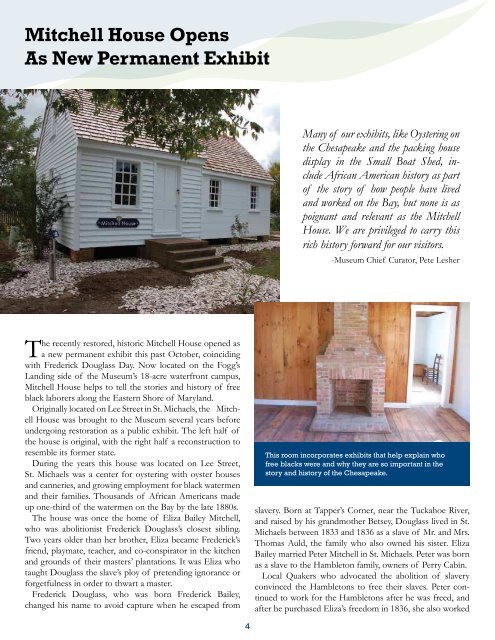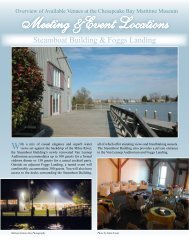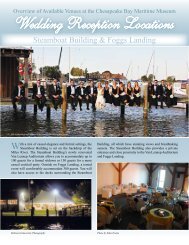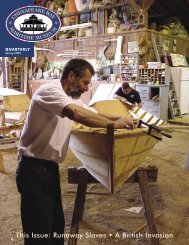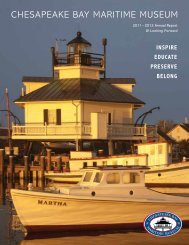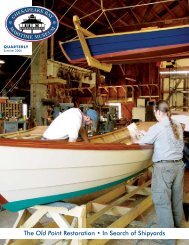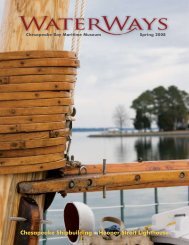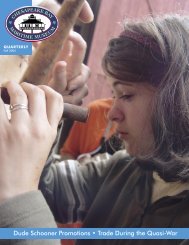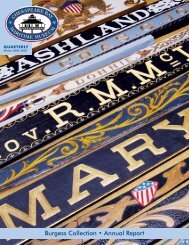Winter - Chesapeake Bay Maritime Museum
Winter - Chesapeake Bay Maritime Museum
Winter - Chesapeake Bay Maritime Museum
Create successful ePaper yourself
Turn your PDF publications into a flip-book with our unique Google optimized e-Paper software.
Mitchell House Opens<br />
As New Permanent Exhibit<br />
The recently restored, historic Mitchell House opened as<br />
a new permanent exhibit this past October, coinciding<br />
with Frederick Douglass Day. Now located on the Fogg’s<br />
Landing side of the <strong>Museum</strong>’s 18-acre waterfront campus,<br />
Mitchell House helps to tell the stories and history of free<br />
black laborers along the Eastern Shore of Maryland.<br />
Originally located on Lee Street in St. Michaels, the Mitchell<br />
House was brought to the <strong>Museum</strong> several years before<br />
undergoing restoration as a public exhibit. The left half of<br />
the house is original, with the right half a reconstruction to<br />
resemble its former state.<br />
During the years this house was located on Lee Street,<br />
St. Michaels was a center for oystering with oyster houses<br />
and canneries, and growing employment for black watermen<br />
and their families. Thousands of African Americans made<br />
up one-third of the watermen on the <strong>Bay</strong> by the late 1880s.<br />
The house was once the home of Eliza Bailey Mitchell,<br />
who was abolitionist Frederick Douglass’s closest sibling.<br />
Two years older than her brother, Eliza became Frederick’s<br />
friend, playmate, teacher, and co-conspirator in the kitchen<br />
and grounds of their masters’ plantations. It was Eliza who<br />
taught Douglass the slave’s ploy of pretending ignorance or<br />
forgetfulness in order to thwart a master.<br />
Frederick Douglass, who was born Frederick Bailey,<br />
changed his name to avoid capture when he escaped from<br />
Many of our exhibits, like Oystering on<br />
the <strong>Chesapeake</strong> and the packing house<br />
display in the Small Boat Shed, include<br />
African American history as part<br />
of the story of how people have lived<br />
and worked on the <strong>Bay</strong>, but none is as<br />
poignant and relevant as the Mitchell<br />
House. We are privileged to carry this<br />
rich history forward for our visitors.<br />
-<strong>Museum</strong> Chief Curator, Pete Lesher<br />
This room incorporates exhibits that help explain who<br />
free blacks were and why they are so important in the<br />
story and history of the <strong>Chesapeake</strong>.<br />
slavery. Born at Tapper’s Corner, near the Tuckahoe River,<br />
and raised by his grandmother Betsey, Douglass lived in St.<br />
Michaels between 1833 and 1836 as a slave of Mr. and Mrs.<br />
Thomas Auld, the family who also owned his sister. Eliza<br />
Bailey married Peter Mitchell in St. Michaels. Peter was born<br />
as a slave to the Hambleton family, owners of Perry Cabin.<br />
Local Quakers who advocated the abolition of slavery<br />
convinced the Hambletons to free their slaves. Peter continued<br />
to work for the Hambletons after he was freed, and<br />
after he purchased Eliza’s freedom in 1836, she also worked<br />
This room displays a pre-Civil War domestic environment.<br />
as a farm laborer. They were living in the house by 1871, and<br />
possibly as early as the 1830s.<br />
In 1972, James E. Thomas, a Mitchell family descendant,<br />
became the first African-American Commissioner of the<br />
Town of St. Michaels and, a few years later, its first elected<br />
president. He was instrumental in saving the Mitchell house<br />
from demolition in 1981.<br />
The Mitchell House exhibit is both inside and out—with<br />
an 1800s swept-earth landscape and heirloom garden, and<br />
the two-room building. One room displays a pre-Civil War<br />
domestic environment. The other will incorporate exhibits<br />
that help explain who free blacks were and why they are so<br />
important in the story and history of the <strong>Chesapeake</strong>.<br />
A swept-earth landscape sits just a few feet away from<br />
the Mitchell House’s front door.<br />
Curator’s Corner<br />
I was not old enough to work in the field . . . .<br />
The most I had to do was to drive up the cows<br />
in the evening, to keep the front yard clean,<br />
and to perform small errands for my young<br />
mistress, Lucretia Auld.<br />
– Frederick Douglass<br />
Keeping the yard clean meant sweeping an expanse<br />
of bare earth around the slave cabin.<br />
Swept earth was a domestic tradition brought by<br />
blacks from West Africa. It helped to keep the<br />
home safe from fires used for outdoor cooking<br />
and washing. It also made the area inhospitable for<br />
insects and pests, and removed hiding places for<br />
snakes.<br />
Shrubs tended to be set out as individual plants<br />
rather than in groups and there were no hedges or<br />
foundation plantings. These yards were also used<br />
for slaughtering, food preparation and storage,<br />
and soap making, leisure and recreation, as well as<br />
ornament and display.<br />
The design and plant selection of the Mitchell<br />
House yard is an effort to recreate the setting<br />
within which Peter and Eliza Bailey Mitchell lived<br />
and raised their family.<br />
They rent about an acre of ground on which<br />
they raise vegetables enough for the family;<br />
they raise their own meat.<br />
– Lewis Douglass describing the Mitchells’ house<br />
to his father, Frederick, 9 June 1865<br />
4 5


